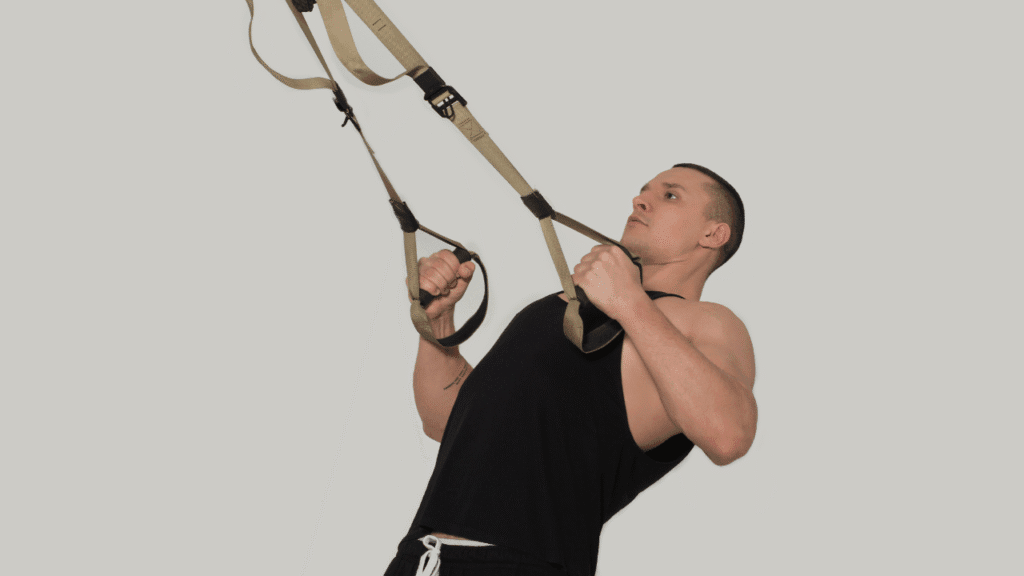How to Suspension Trainer Curl for Bigger Biceps

Yo, If you want bigger biceps without touching a single dumbbell—this is the content you’ve been waiting for. Today, we’re diving into the suspension trainer curl—one of the most underrated bodyweight moves that will torch your arms and make your sleeves beg for mercy. Whether you’ve got a TRX or any basic suspension strap setup, we’re unlocking the blueprint for beast-mode biceps using nothing but your bodyweight and some grit. and let’s break down this epic arm builder step-by-step. No gym? No problem. Let’s curl!
1 – What is the Suspension Trainer Curl?
The suspension trainer curl is a bodyweight exercise that mimics a preacher curl—except you’re hanging from straps and flexing through pure tension. Think of it as the lovechild of calisthenics and old-school bodybuilding. It hammers the biceps with constant tension, especially the long head, giving your arms that juicy peak. The best part? You control the difficulty by changing your angle. Closer to the ground = more resistance. Farther back = easier. It’s scalable, simple, and perfect for training anywhere. Let’s dig into setup, form, and why this move hits harder than your average dumbbell curl.
2 – Proper Setup & Strap Adjustment
First, anchor your suspension trainer securely—door frame, pull-up bar, tree branch, whatever you’ve got. Adjust the handles so they hang about waist height. Stand facing the anchor point, grip the handles with palms facing up, and walk your feet forward to lean back. Your body should form a diagonal line from head to heel. The lower you go, the tougher it gets. Keep those straps tight—no slack, no sag. Engage your core, squeeze your glutes, and get ready to work. This is all about control and tension. Sloppy setup equals sloppy gains. Lock it in, and let’s move!
3 – Hand Positioning & Grip Control
Your grip can make or break this movement. Keep your palms supinated (facing up) throughout the entire rep. Don’t rotate your hands mid-movement—this is all about isolating the biceps, not cheating with your forearms. Wrap your thumbs around the handles for control, but don’t death grip them—you want tension in your arms, not your wrists. Keep your wrists neutral and aligned with your forearms. If you feel strain in your forearms or shoulders, check your grip and back off the angle. Mastering grip means better activation and way more control. Keep those hands in the game!
4 – Curling With Control, Not Momentum
No swinging, no jerking, no ego. Every rep should look like it’s in slow motion. Start from full extension—arms straight, core braced. Pull your body upward by bending only your elbows. Your upper arms should stay locked in place, like you’re glued to an invisible wall behind you. Squeeze your biceps hard at the top, then slowly lower yourself back to the start. Tempo is your secret weapon here—think 2 seconds up, 3 seconds down. It’s not about reps, it’s about time under tension. More control = more gains. Curl like you mean it.
5 – Common Mistakes to Avoid
Alright, let’s kill bad form before it kills your progress. Mistake #1: Using your shoulders to initiate the pull. That’s a back workout, not a biceps curl. Mistake #2: Letting your hips sag or rise—this breaks the line and steals tension from your arms. Mistake #3: Rushing through reps. This ain’t cardio. You want deep, controlled contractions. Mistake #4: Flared elbows. Keep them tight, close to your sides. Fixing these will instantly boost your results and prevent injury. Film yourself or use a mirror. Check yourself before you wreck your curl gains.
6 – Progressive Overload (Bodyweight Style)
You don’t need weights to level up. Progressive overload still applies—just bodyweight edition. Want more resistance? Lower your body closer to the ground, increasing the angle. Add pauses at the top. Slow down the negative. Throw in a drop set by stepping back mid-set to an easier angle and continuing the burn. You can also go one-arm eccentric (lower down with one arm). The possibilities are endless. Keep track of your volume and intensity. Challenge equals change—and suspension curls give you that raw, functional tension that builds arms built to flex and perform.
7 – Suspension Curl Variations to Try
Bored with the basics? Try these sick variations.
One-Arm Curls – For crazy isolation and core work.
Offset Grip Curls – One handle higher than the other = asymmetrical challenge.
Paused Reps – Hold at the top for a 3-second flex.
21s – Do 7 bottom-half reps, 7 top-half reps, then 7 full-range curls.
Superset with Rows – Biceps + back in one brutal combo.
Mix and match these to keep your workouts fresh and your biceps guessing. Adapt or plateau—your call.
8 – Frequency & Workout Placement
How often should you hit these curls? If you’re training full-body or upper body 3-4 times a week, throw in suspension curls 2-3 times. Put them after compound pulling exercises like rows or pull-ups when your biceps are already warmed up and pre-fatigued. Aim for 3-4 sets of 8-12 reps—or more if you’re chasing volume. If you’re doing a biceps-focused finisher, burn out with higher reps and shorter rest. Listen to your body, track your pump, and give your arms enough recovery. Consistency + intensity = growth.
9 – Why Suspension Curls Hit Different
There’s something special about these curls—they train your arms and your whole body. You’re not just moving your biceps; you’re engaging your core, stabilizing your spine, and managing total-body tension. Plus, there’s no machine doing the work for you. You own every inch of the movement. That deep squeeze at the top? That’s pure, unassisted contraction. It builds strength, control, and aesthetics all in one. Suspension curls turn bodyweight training into an art—and your arms into weapons. It’s minimalist, effective, and crazy versatile.
10 – Tracking Progress for Max Gains
Let’s talk metrics. Gains don’t come from guessing. Log your angles, reps, tempo, and how close to failure you’re pushing. Take weekly progress pics of your arms. Measure your biceps monthly. Track strength gains by noting how low you can go without breaking form. Add difficulty as you adapt—more range, slower reps, harder variations. Don’t just do the movement—master it. Training smarter, not just harder, separates the flexers from the fakers. Be your own coach, and the mirror will start applauding.
There you have it—your blueprint for suspension trainer curls that’ll blow up your biceps with zero weights and zero excuses. Master the form, avoid the mistakes, scale the difficulty, and you’ll start seeing growth fast. Whether you’re working out in a home gym, hotel room, or a park, these curls are your secret weapon for arm gains on the go.
Men’s trending fashion and how to look attractive. Here teaching fashion, so make sure to check it out.
Men’s Fitness tips, what you eat and how to stay fit your body. The best workout and best diet plan, so make sure to check it out.
Men’s lifestyle tips, how to live a better life, and changing your lifestyle tips, so make sure to check them out.
It cannot be denied that men have finally come to their senses when it comes to good grooming and fashion statement.
Men are also equally frustrated with bad hair days in their life, even though not as annoyed as women. Even though men have short haircuts, they also face problems in maintaining their hair.
There are no formulae for success but there are some successful entrepreneur tips that can help make things a little simpler.









